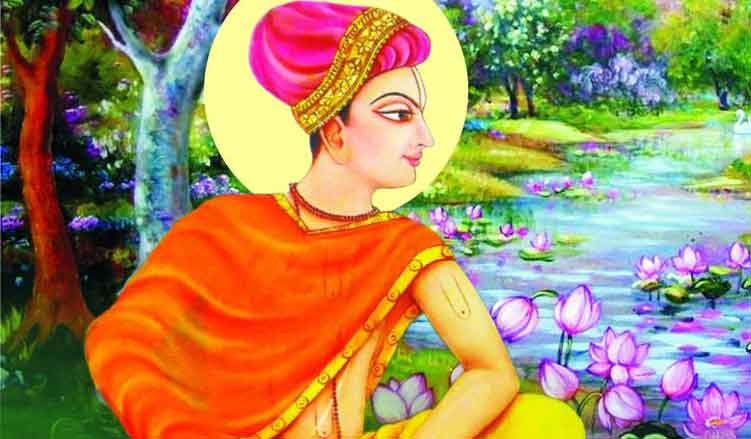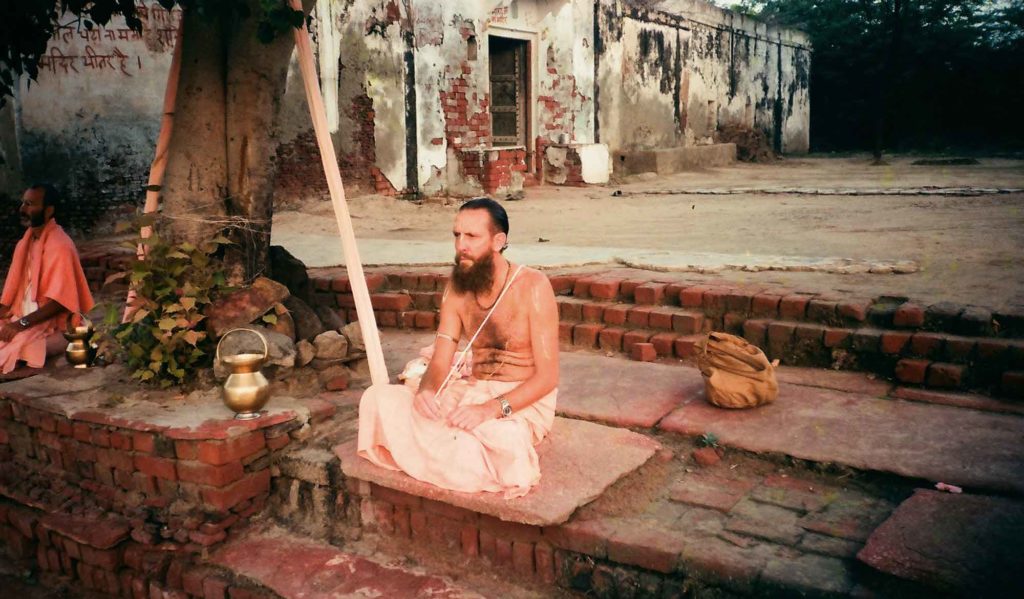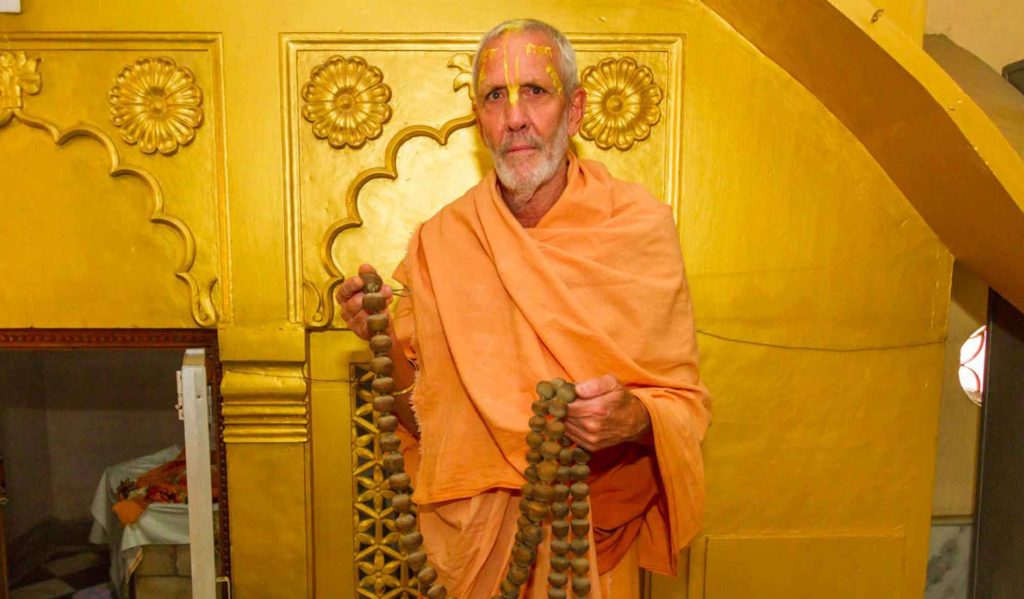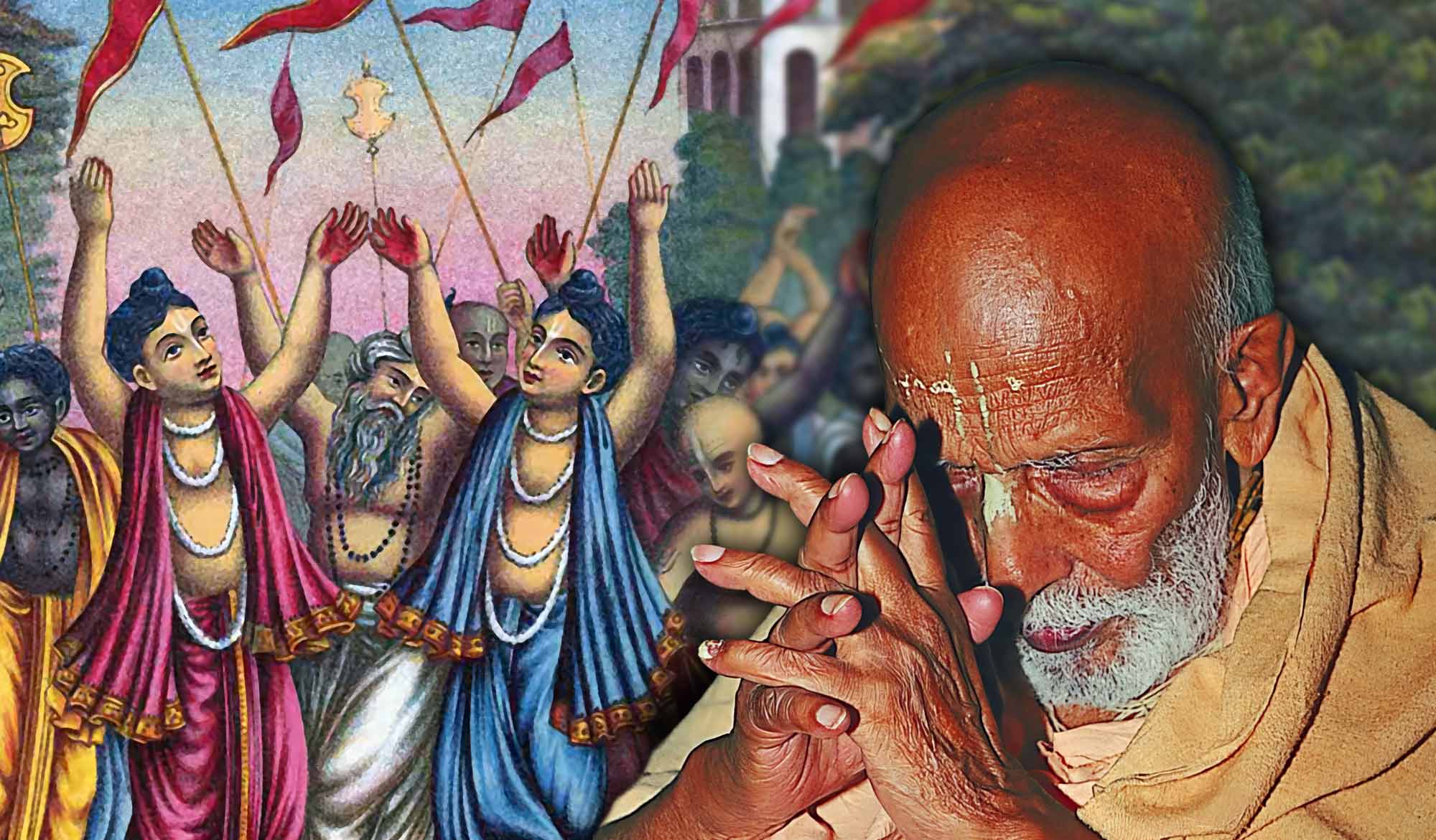Overview
In "Hita Harivaṁśa and the Rādhā-Vallabha Sect" Swami B.V. Giri narrates the history of Hita Harivaṁśa of Vṛndāvana and his connection to Śrīla Gopāla Bhaṭta Gosvāmī and Prabodhānanda Sarasvatī. He also explains the philosophy of the Rādhā-Vallabha sect and how they reject the aṅgas of vaidhi-bhakti.
Question: There is a famous temple (Rādhā-Vallabha Mandira) in Vṛndāvana where the Deities of Rādhā-Vallabha are worshipped and which is visited by many western devotees when they come to Vraja. What is the background of this temple and does it have any link with the Gauḍīya sampradāya and its philosophy?
Answer: The Rādhā-Vallabha Mandira belongs to the followers of Hita Harivaṁśa who was the founder of the Rādhā-Vallabha sect and of the siddhādvaita-vāda philosophy. The Rādhā-Vallabhas should not be confused with the Vallabha sampradāya of Vallabhācārya, which is another story. The Rādhā-Vallabha Temple in Vṛndāvana has no actual connection with the Gauḍīya sampradāya although Harivaṁśa himself originally did.
Harivaṁśa was born in 1502 near Mathurā into a Gauḍa brāhmaṇa family. Later on in life he went to Vṛndāvana where, according to various Gauḍīya Vaiṣṇava hagiographies and works such as the Gauḍīya Vaiṣṇava Abhidhāna, he became the disciple of Śrīla Gopāla Bhaṭṭa Gosvāmī. Unfortunately, sometime after, Harivaṁśa was rejected by Gopāla Bhaṭṭa Gosvāmī when he obstinately refused to stop taking betal-nut prasāda on Ekādaśī claiming that he was instructed to do so by Śrīmatī Rādhārāṇī. This very much displeased Gopāla Bhaṭṭa Gosvāmī who then rejected Harivaṁśa as his disciple. Śrīla Bhakti Rakṣaka Śrīdhara Deva Gosvāmī Mahārāja comments on this subject:
There was one disciple of Gopāla Bhaṭṭa by the name Harivaṁśa. He was of a little different type, something like sahajiyā. He was seen one day to chew betel-nut in the Ekādaśī fasting day but objection was raised by other disciples of Gopāla Bhaṭṭa. Harivaṁśa, started a section named Harivaṁśī. (Rādhā-Vallabha). Harivaṁśa himself was a disciple of Gopāla Bhaṭṭa, but some difference. Little slackness in the strict life of faith. Śrīla Rūpa Gosvāmī says we must observe vaidhi-bhakti for as long as we can’t get admission into the level of rāga-bhakti. Dāsa Gosvāmī also says we shall show reverence to rāga-bhakti, but we shall try to live within vaidhi-bhakti, rules and regulations, śāstra regulated devotion. But the arrogant do not care for this instruction of the followers of Śrī Caitanya Mahāprabhu. This party (Harivaṁśa / Rādhā-Vallabha) says that they have connection with the Gopāla Bhaṭṭa sampradāya – Gauḍīya Vaiṣṇavism with a little deviation. They want to begin with rāga-bhakti, anurāga.
They are worse than sahajiyās! Sahajiyāism formerly accepts everything, but they want easy entrance to do only what comes naturally without work, and they don’t admit the necessity for formal devotion. They are lazy in their practice, preferring the enjoying mood to the serving mood, but service means sacrifice. So the atmosphere is dangerous and any theistic awakening we should mark with all attention and care so that we may not go down again to the depths of nescience. Very carefully we shall try to collect our wealth. Real progress towards the Infinite gives the idea, ‘That I am nothing, I am in great danger.’ Progress towards the Infinite is like that. ‘Thinking I have it, I am above.’ This is a foolish feeling, foolish statement. The very nature of advancement is that, ‘I am low, I am undone, I am the most helpless.’ The closer we are the further away we will feel, whereas the further away we actually are from divinity – we may complacently feel we are close. As much as we come into the relativity of the Infinite, we cannot but conceive ourselves to be the lowest of the low. That is the criteria.
The very sign of real progress will show I am nothing, I am the most needy, the most wretched and the most helpless. The negative aspect must be improved to attract the positive. If one point of the negative will say, ‘I am positive’ then immediately it will be rejected, you are under the false control of māyā. Rather to think, ‘I am the meanest of the mean,’ that will attract the attention of the high. This is the science of devotion proper. (Conversation, Navadvīpa 1983)
So Harivaṁśa was definitely rejected by Śrīla Gopāla Bhaṭṭa Gosvāmī, as confirmed by Śrīla Śrīdhara Mahārāja. Naturally however, it stands to reason that the followers of Harivaṁśa deny this story vehemently and claim that when Harivaṁśa was seven years old he had a dream that Rādhārāṇī initiated him into the sacred yugala-mantra, thus they declare that he actually took dīkṣā directly from Rādhārāṇī Herself and not Gopāla Bhaṭṭa Gosvāmī. Such a dubious story was even contested and doubted during Harivaṁśa’s lifetime by some of his own disciples, such as Viṭṭhala Dāsa. It would thus seem that Harivaṁśa’s rejection by his guru Śrīla Gopāla Bhaṭṭa resulted in his fabricating the story of his initiation by Rādhārāṇī in order to cover over his embarrassing predicament and simultaneously gain some distinction from the public.
The biographies of Hita Harivaṁśa written by his followers go on to state that although Harivaṁśa was already married by the time he was in his early 30’s, he left his wife and children and took two co-wives, Kṛṣṇa Dāsī and Manoharī Dāsī again claiming that he had been instructed to do so by Śrīmatī Rādhārāṇī. From such instances, it appears that Harivaṁśa did not exhibit proper sadācāra (exemplary Vaiṣṇava behaviour) and thus cannot be considered a pure devotee in the line of Śrī Caitanya Mahāprabhu.
In 1535, with the help of a wealthy Gujarati named Lālubhāi, he built the Rādhā-Vallabha Temple and installed the Deities of Rādhā-Vallabha at Purana Sahar in Vṛndāvana. The temple quickly gained much popularity amongst the public, but not among the pure Vaiṣṇavas. It is said that Harivaṁśa died in 1609.
The difference between Harivaṁśa and the Gauḍīya Vaiṣṇava sampradāya does not end in Harivaṁśa’s rejection by Gopāla Bhaṭṭa Gosvāmī.
According to the Rādhā-Vallabha sect, Harivaṁśa dictated the book, Rādhā-rasa Sudhā Nidhi when he was only six months old and it was written down by his uncle Nṛsiṁhāśrama. This fantastical story is disputed by the Gauḍīyas who declare that it was actually Śrīla Prabodhānanda Sarasvatī who composed the Rādhā-rasa Sudhā Nidhi. Almost all of Harivaṁśa’s works are written in the local Vraja-bhāṣa dialect of Vṛndāvana except his Yamunāṣṭakam (and it is still debated by many scholars whether this was written by him at all). However, if one compares the works of Harivaṁśa and Śrīla Prabodhānanda, one will observe that the same linguistic style is prevalent throughout all of Prabodhānanda’s works such as Āścarya-rāsa-prabandha, Navadvīpa-śatakam, Saṅgīta-mādhava, Caitanya-candrāmṛtam and Vṛndāvana-mahimāmṛta. Thus it is most likely that the followers of Harivaṁśa plagiarised the Rādhā-rasa Sudhā Nidhi and attributed it to their founder by concocting the implausible tale of Harivaṁśa composing this work when he was only six-months old.
Another important point that separates the Gauḍīyas from the Rādhā-Vallabha sect is that Harivaṁśa rejected the injunctions of the scriptures. He rejected the rules of Deity worship, the ten saṁskāras (purificatory rites), the importance of fasting on Ekādaśī, the worship of śālagrāma-śilā and the worship of Tulasī Devī. These aspects of sādhana rejected by Harivaṁśa are all in the realm of vaidhi-bhakti. Persons such as Harivaṁśa and other pseudo-Vaiṣṇavas state that there is no need of following these regulations because the residents of Goloka do not follow them. Since one must take shelter (anugatya) of an eternal resident of Vraja-dhāma, we should follow in their footsteps and reject the aṅgas of vaidhi-bhakti that hinder our attempts to perform rāgānuga-sādhana. This is the misguided opinion of the Rādhā-Vallabha sect.
Furthermore, they opine that since Kṛṣṇa loves His devotees, He becomes happier when they live a life of luxury and material comfort than when they perform devotional austerities (such as fasting on Ekādaśī, Janmāṣṭamī etc). Thus the Rādhā-Vallabha sect belittles any type of asceticism and uphold their founder’s lifestyle of sensuality as superior to that of the lifestyle of Śrī Rūpa and Śrī Raghunātha Dāsa Gosvāmī.
That one must take shelter of an eternal resident of Vraja is also accepted by the Gauḍīyas, but it is not accepted that one should arbitrarily reject practices favourable for cultivating proper devotional sentiments. Śrīla Rūpa Gosvāmī Prabhupāda has written thus:
kṛṣṇaṁ smaran janaṁ cāsya preṣṭhaṁ nija-samīhitam
tat-tat-kathā-rataś cāsau kuryād vāsaṁ vraje sadā
“One (who treads the path of rāgānuga-bhakti) always resides in Vraja by constantly remembering his most beloved Śrī Kṛṣṇa and His dear associates and by following their sentiments one has a burning desire for the service of one’s beloved Lord.
sevā sādhaka-rūpeṇa siddha-rūpeṇa cātra hi
tad-bhāva-lipsunā kāryā vraja-lokānusārataḥ
In Vraja, one engaged in spiritual practices under the guidance of a resident of Vraja with an eager desire in the wake of bhāvas (feelings and sentiments towards the Divine Couple) should serve Them both, whether at the stage of a sādhaka or at the stage of a siddha.” (Bhakti-rasāmṛta-sindhu 2:294-5)
However, in his commentary to these verses, Śrīla Viśvanātha Cakravartī Ṭhākura has explained that even in ones sādhaka-deha one must follow the various aṅgas of vaidhi-bhakti:
etena vraja-loka-padena vraja-stha-śrī-rādhā-candrāvaly-ādyā eva grāhyāḥ. tāsām anusāreṇaiva sādhaka-dehena kāyiky-ādi-sevāpi kartavyā. evaṁ sati tābhir guru-pādāśrayaṇaikādaśī-vrata-śālagrāma-tulasī-sevādayo na kṛtāḥ. tad-anugatair asmābhir api na kartavyā ity ādhunika-sauramya-matam api nirasta mata eva śrī-jīva-gosvāmi-caraṇair apy asya granthasya ṭīkāyāṁ durgama-saìgamanī-nāmnyāṁ tathaivoktam. tad yathā—vraja-lokās tv atra kṛñṇa-preñṭha-janās tad-anugatāś ca tad-anusārataḥ.
atha rāgānugāyāḥ paripāṭīm āha kṛṣṇam ity ādinā. preṣṭhaṁ sva-priyatamaṁ kiśoraṁ nanda-nandanaṁ smaran evam asya tādṛśa-kṛñṇasya bhakta-janam. atha ca svasya samyag-īhitaṁ sva-samāna-vāsanam iti yāvat. tathā ca tādṛśaṁ janaṁ smaran vraje vāsaṁ kuryāt. sāmarthye sati śrīman-nanda-vrajāvāsa-sthāne śrī-vṛndāvanādau śarīreṇa vāsaṁ kuryāt. tad-abhāve manasāpīty arthaḥ
“Someone may argue that the word ‘vraja-loka‘ only refers to Śrīmatī Rādhārāṇī, Lalitā etc, then with the sādhaka-deha one should perform bodily services following in their foot-steps. If this were so, then the followers of the Lord’s dear-most associates would find it unnecessary to perform the aṅgas of devotion such as taking shelter of a spiritual master (śrī-guru-pādāśraya), observing Ekādaśī-vrata, worship of śālāgrāma, worship of Tulasī etc, since it is not mentioned anywhere that Rādhārāṇī and Lalitā ever performed these activities. This mistaken conclusion accepted by those who have taken shelter of modern heretical opinions is also refuted by the word vraja-loka.
In his commentary to this verse of Bhakti-rasāmṛta-sindhu, Śrīla Jīva Gosvāmīpāda has explained the same thing; namely, that the word vraja-loka not only refers to the dear-most associates of Śrī Kṛṣṇa but to their followers such as Śrī Rūpa Gosvāmī and others. Thus, one should perform internal service (manasī-sevā) through one’s siddha-deha by following in accordance with Śrī Rūpa Mañjarī and other Vraja-vāsīs. With the sādhaka-deha, one should perform bodily service by following Śrī Rūpa Gosvāmī and others.” (Bhakti-rasāmṛta-sindhu-bindu)
Śrīla Rūpa Gosvāmī, Śrīla Raghunātha Dāsa Gosvāmī and other great Vaiṣṇava saints observed Ekādaśī, tulasī-pūjā, śālagrāma-pūjā etc. though such activities of vaidhi-bhakti are not performed by the vraja-gopīs. Śrīla Viśvanātha Cakravartī explains in his Bhakti-rasāmṛta-sindhu-bindu that various aṅgas of vaidhi-bhakti which are compatible for the cultivation of rāgānuga-bhakti should not be discarded, such favourable aṅgas of vaidhi-bhakti are classified as bhāvamaya, bhāva-sambandhī, bhāvānukula and bhāvāviruddha. However, some of the aṅgas of vaidhi-bhakti are antagonistic to developing spontaneous love for the Lord (bhāva-pratikūla) such as nyāsa (placing various mystic syllables on the body for purification), mudrā (hand-gestures used in Deity worship), ahaṁgrahopāsana (identifying oneself with one’s worshipful Deity), dvārakā-dhyānam (meditation upon Kṛṣṇa’s pastimes in Dvārakā) and rukmiṇyādi-pūjā (worship of Rukmiṇī Devī and the other queens of Dvārakā).
Unless one accepts this concept and method of rāgānuga-sādhana, it is certain that one will become bewildered and fall into a quagmire of mental concoction in the unripe stage of his spiritual life. So long as one is conditioned and under the influence of the modes of nature, it is imperative to follow the path of vaidhi-bhakti-sādhana. Initially the neophyte must clear his anarthas, and only then can he develop a spontaneous taste for devotional service through the medium of chanting the Holy Name etc. Then an intense desire automatically appears in the heart to follow in the footsteps of the eternal associates of Śrī Śrī Rādhā-Govinda. When such an intense and genuine desire appears, the aspirant is no longer bound by the rules of the scriptures, yet he does not abandon the scriptural rules either.
However, this is not a simple achievement and caution must be taken at every step. To achieve such a rare gift one must first receive the special grace of Śrī Guru and the other residents of Vraja-dhāma. If one is misled and simply imitates those who are real relishers of rāgānuga–bhajana, discarding the preliminary path of vaidhi-bhakti capriciously, then the result will only be confusion and ruination.
The story of Harivaṁśa’s dismissal by Śrīla Gopāla Bhaṭṭa due to his willingness to break the Ekādaśī-vrata seems highly plausible when one reads the Rādhā-Vallabha work ‘Sevā-sakhī Vāṇī‘. In there it is mentioned that Harivaṁśa rejected all fast-days because it denied him the pleasure of taking prasādam. Concerning Ekādaśī, it would be poignant here to compare Harivaṁśa’s contrast of mood to that of Śrī Caitanya Mahāprabhu:
“Lord Caitanya said, “To not observe complete fasting on Ekādaśī will greatly endanger one’s spiritual life. Honour prasādam on Ekādaśī only by offering it obeisances and eating it the next day. In this way, one can easily cross this material ocean. The fast is any way over on the following day. The non-Vaiṣṇavas gormandise without control, offering only lame excuses that they are honoring mahā-prasādam. They do this on Ekādaśī, because they are engrossed day and night in sense enjoyment. They enjoy grains and rice on Ekādaśī and thereby eat the sins that enter grains on such days, disregarding the sanctity of Ekādaśī-vrata. You must diligently execute devotional service and respect the process of devotion. You will then surely receive the blessings of Bhakti Devī Herself. Avoid the association of non-devotees and properly observe the Ekādaśī-vrata by constantly chanting the holy name.” (Chapter 18, Prema-vivarta, by Śrī Jagadānanda Paṇḍita).
The holy day of Ekādaśī was considered to be so important by the Gauḍīya smṛti–ācārya, Śrīla Gopāla Bhaṭṭa Gosvāmī, that he dedicated an entire chapter to it in his Hari–bhakti–vilāsa. Little wonder then that he was highly disappointed with the negligent behaviour of his errant disciple, Harivaṁśa.
Some sections of the Rādhā-Vallabhīs consider Harivaṁśa to be the joint incarnation of Śrī Kṛṣṇa and His flute (hence the name ‘hari-vaṁśa‘), whereas others opine that he is the incarnation of Śrī Lalitā-sakhī. If this indeed was the case, it seems unlikely that Harivaṁśa would encourage the general populace to directly oppose the injunctions of the scriptures and claim that one’s own ‘spiritual revelations’ carry more relevance. If there is no scriptural boundary set, then anyone can claim that their own ‘spiritual revelations’ carry more weight than the scriptures. Anyone can claim anything as a genuine path to attain the highest goal. Thus, the śāstras and their laws become immaterial and society is cast into chaos. By following such a contrived mode of sādhana one will only find himself in darkness. Therefore, in Bhagavad-gītā (16:23-24) Śrī Kṛṣṇa tells Arjuna:
yaḥ śāstra-vidhim utsṛjya vartate kāma-kārataḥ
na sa siddhim avāpnoti na sukhaṁ na parāṁ gatim
tasmāc chāstraṁ pramāṇaṁ te kāryākārya-vyavasthitau
jñātvā śāstra-vidhānoktaṁ karma kartum ihārhasi
“One who acts whimsically, rejecting the scriptural injunctions, attains neither perfection, happiness nor the supreme goal of life. Thus the scriptures are your authority in deciding what is to be done and what is not to be done. Understanding their injunctions, you should act accordingly in this world.”
Related Articles
- A Rūpānuga’s Constant Meditation Concerning Śrī Ratha Yātrā by Śrīla B.R. Śrīdhara Mahārāja
- Śrī Nimbāditya and Nimbārka Are Not the Same Person by Śrīla Bhakti Prajñāna Keśava Mahārāja
- Ratha Yātrā in Navadvīpa by Śrīla Bhakti Gaurava Narasiṅgha Mahārāja
- A Brief Response to Ratha Yatra in Navadvīpa by Śrīla Bhakti Gaurava Narasiṅgha Mahārāja
- Bhaktivedānta by Śrīla Bhakti Gaurava Narasiṅgha Mahārāja
- Śrīdhara Deva Gosvāmī by Śrīla Bhakti Gaurava Narasiṅgha Mahārāja
- Ativāḍī Apa-Sampradāya by Śrīla Bhakti Gaurava Narasiṅgha Mahārāja
- Hita Harivaṁśa and the Rādhā-Vallabha Sect by Swami B.V. Giri
- The Temple of Understanding by Śrīla Bhakti Gaurava Narasiṅgha Mahārāja
- Māyāpura and the Adbhūta Mandira by Śrīla Bhakti Gaurava Narasiṅgha Mahārāja
- The Adbhūta Mandira and Bhaktivinoda’s Vision by Śrīla Bhakti Gaurava Narasiṅgha Mahārāja
- Nimbārka and Keśava Kāśmīrī by Śrīla Bhakti Gaurava Narasiṅgha Mahārāja
- The Mystery of the History of the Līlā of Dāmodara by Śrīla Bhakti Gaurava Narasiṅgha Mahārāja
- Prabodhānanda and Prakāśānanda by Swami B.V. Giri
Further Reading
- A Discussion in Relation to the Dates of the Six Gosvāmīs by Śrīla Bhaktivinoda Ṭhākura
- Śrī Śrī Rūpa Gosvāmī Prabhu by Śrīla Bhaktivinoda Ṭhākura
- Śrī Śrī Sanātana Gosvāmī Prabhu by Śrīla Bhaktivinoda Ṭhākura
- Śrī Śrī Gopāla Bhaṭṭa Gosvāmī Prabhu by Śrīla Bhaktivinoda Ṭhākura
- Śrī Śrī Jīva Gosvāmī Prabhu by Śrīla Bhaktivinoda Ṭhākura
- Śrī Śrīnivāsa Ācārya Prabhu by Śrīla Bhaktivinoda Ṭhākura
- Śrī Śrī Kṛṣṇa Dāsa Kavirāja Gosvāmī Prabhu by Śrīla Bhaktivinoda Ṭhākura
- Śrī Śrī Prabhu Rāmacandra Gosvāmī by Śrīla Bhaktivinoda Ṭhākura
- Kavi Rāma Prasāda (The Poet Rāma Prasāda) by Śrīla Bhaktivinoda Ṭhākura
- Śrī Śrī Abhirāma Gosvāmī by Śrīla Bhaktivinoda Ṭhākura
- Śrī Parameśvarī Dāsa by Śrīla Bhaktivinoda Ṭhākura
- Śrī Jāhnavā Devī by Śrīla Bhaktivinoda Ṭhākura
- Salve for the Eyes of the Blind by Śrīla Bhaktivinoda Ṭhākura
- Śrī Bhāgavatācārya by Śrīla Bhaktivinoda Ṭhākura
- The Place of Śrīla Bhāgavatācārya by Śrīla Bhaktivinoda Ṭhākura
- The Inauguration of a Prapannāśrama in Amaljoda by Śrīla Bhaktivinoda Ṭhākura
- A Question and Answer Concerning Śrī Kṛṣṇa Saṁhitā (Praśnottara) by Śrīla Bhaktivinoda Ṭhākura
- An Earnest Appeal by Śrīla Bhaktivinoda Ṭhākura
- Śrī Śrī Hari Dāsa Ṭhākura’s Place in Kulīnagrāma by Śrīla Bhaktivinoda Ṭhākura
- The Place of Śrī Nakula Brahmacārī by Śrīla Bhaktivinoda Ṭhākura
- Śrīpāṭa Denuḍa by Śrīla Bhaktivinoda Ṭhākura
- Śrīdhāma Māyāpura by Śrīla Bhaktivinoda Ṭhākura
- Śrī Śyāmānanda Gosvāmī by Śrīla Bhaktivinoda Ṭhākura
- Śrī Māna Sarovara by Śrīla Bhaktivinoda Ṭhākura
- Gata-varṣa (The Last Year) by Śrīla Bhaktivinoda Ṭhākura
- The Temple of Śrī Śrī Jagannāthadeva by Śrīla Bhaktivinoda Ṭhākura
- Nāḍā by Śrīla Bhaktivinoda Ṭhākura
- The Instructions of Śrīmad Rāmānuja Svāmī – the Ācārya of the Śrī Sampradāya by Śrīla Bhaktivinoda Ṭhākura
- Śrīman Nimbāditya by Śrīla Bhaktivinoda Ṭhākura
- Śrī Acyutānanda’s Departure by Śrīla Bhaktivinoda Ṭhākura
- British Rule and the Vaiṣṇavas by Śrīla Bhaktivinoda Ṭhākura
- The Society of Śrī Gaurāṅga by Śrīla Bhaktivinoda Ṭhākura
- The Temple of Jagannath at Puri by Śrīla Bhaktivinoda Ṭhākura
- A Review of the Previous Year by Śrīla Bhaktivinoda Ṭhākura
- Prabodhānanda and Prakāśānanda by Śrīla Bhaktivinoda Ṭhākura
- Rādhā-kuṇḍa and Śyāma-kuṇḍa by Śrīla Bhaktivinoda Ṭhākura
- Puratana Gañja of Śrīdhāma Navadvīpa by Śrīla Bhaktivinoda Ṭhākura
- What Has Happened in Śrī Māyāpura? by Śrīla Bhaktivinoda Ṭhākura
Prabhupāda Śrīla Sarasvatī Ṭhākura’s Visit to Ayodhyā
With the forthcoming observance of Śrī Rāma Navamī, we present 'Prabhupāda Śrīla Sarasvatī Ṭhākura’s Visit to Ayodhyā' written by Śrīla Bhaktisiddhānta Sarasvatī Ṭhākura Prabhupāda from The Gaudīyā magazine, Vol 3. Issue 21/ In December 1924, after visiting Benares and Prāyāga, Sarasvatī Ṭhākura visited the birth-site of Śrī Rāmācandra in Ayodhyā.
Śaraṇāgati – The Only Path to Auspiciousness
In this article, 'Śaraṇāgati - The Only Path to Auspiciousness', Dhīra Lalitā Dāsī analyses the process of śaraṇāgati (surrender) beginning with śraddhā (faith). She also discusses the role of śāstra and the Vaiṣṇava in connection with surrender.
Ātma Samīkṣā – The Value of Introspection
In this article, "Ātma Samīkṣā – The Value of Introspection" Kalki Dāsa highlights the importance of introspection in the life of a devotee and especially in relation to the worldly environment that surrounds us. He also explains how transcendental sound influences our capacity to introspect.
Svasti No Gaura-vidhur Dadhātu (May the Moon-like Gaura Bestow Auspiciousness)
This Bengali poem, ‘Svasti No Gaura-vidhur Dadhātu,’ (May the Moon-like Gaura Bestow Auspiciousness) written by Śrīla Bhakti Pramoda Purī Gosvāmī, was first published in 1965 in Caitanya Vāṇī magazine, Vol.5, Issue 1. In this composition, Śrīla Purī Mahārāja gives advice to the fallen jīvas to sincerely accept Mahāprabhu's gift of the Holy Name. This poem was translated into English by Sanātana Dāsa and Parameśvarī Devī Dāsī.
Prabhupāda Śrīla Sarasvatī Ṭhākura’s Visit to Ayodhyā
With the forthcoming observance of Śrī Rāma Navamī, we present 'Prabhupāda Śrīla Sarasvatī Ṭhākura’s Visit to Ayodhyā' written by Śrīla Bhaktisiddhānta Sarasvatī Ṭhākura Prabhupāda from The Gaudīyā magazine, Vol 3. Issue 21/ In December 1924, after visiting Benares and Prāyāga, Sarasvatī Ṭhākura visited the birth-site of Śrī Rāmācandra in Ayodhyā.
Śaraṇāgati – The Only Path to Auspiciousness
In this article, 'Śaraṇāgati - The Only Path to Auspiciousness', Dhīra Lalitā Dāsī analyses the process of śaraṇāgati (surrender) beginning with śraddhā (faith). She also discusses the role of śāstra and the Vaiṣṇava in connection with surrender.
Ātma Samīkṣā – The Value of Introspection
In this article, "Ātma Samīkṣā – The Value of Introspection" Kalki Dāsa highlights the importance of introspection in the life of a devotee and especially in relation to the worldly environment that surrounds us. He also explains how transcendental sound influences our capacity to introspect.
Svasti No Gaura-vidhur Dadhātu (May the Moon-like Gaura Bestow Auspiciousness)
This Bengali poem, ‘Svasti No Gaura-vidhur Dadhātu,’ (May the Moon-like Gaura Bestow Auspiciousness) written by Śrīla Bhakti Pramoda Purī Gosvāmī, was first published in 1965 in Caitanya Vāṇī magazine, Vol.5, Issue 1. In this composition, Śrīla Purī Mahārāja gives advice to the fallen jīvas to sincerely accept Mahāprabhu's gift of the Holy Name. This poem was translated into English by Sanātana Dāsa and Parameśvarī Devī Dāsī.








